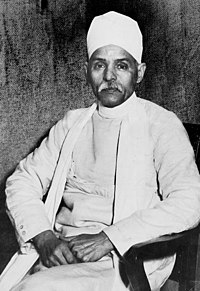Madan Mohan Malaviya | |
|---|---|
 | |
| 3rd Vice-Chancellor of Banaras Hindu University | |
| In office 1919–1938 | |
| Preceded by | P. S. Sivaswami Iyer |
| Succeeded by | Sarvepalli Radhakrishnan |
| President of the Indian National Congress | |
| In office 1909–1910 | |
| Preceded by | Rash Behari Ghosh |
| Succeeded by | William Wedderburn |
| In office 1918 | |
| Preceded by | Annie Besant |
| Succeeded by | Syed Hasan Imam |
| In office 1932–1933 | |
| Preceded by | Vallabhbhai Patel |
| Succeeded by | Nellie Sengupta |
| Personal details | |
| Born | 25 December 1861 Allahabad, North-Western Provinces, British India (present-day Prayagraj, Uttar Pradesh, India) |
| Died | 12 November 1946 (aged 84) Allahabad, United Provinces, British India (present-day Prayagraj, Uttar Pradesh, India) |
| Political party | Congress Nationalist Party Akhil Bharatiya Hindu Mahasabha |
| Other political affiliations | Indian National Congress (formerly) |
| Spouse | Kumari Kundan Devi Malaviya |
| Children | 6 (including Govind Malaviya) |
| Education | University of Calcutta (BA) |
| Profession | |
| Awards | Bharat Ratna (2015) (posthumous) |
| Signature |  |
Madan Mohan Malaviya () (25 December 1861 — 12 November 1946) was an Indian scholar, educational reformer and activist notable for his role in the Indian independence movement. He was president of the Indian National Congress three times and the founder of Akhil Bharat Hindu Mahasabha. He was addressed as Pandit,[1] a title of respect.
Malaviya strove to promote modern education among Indians and co-founded the Banaras Hindu University (BHU) at Varanasi in 1916, which was created under the 1915 BHU Act. It is the largest residential university in Asia and one of the largest in the world,[2] with over 40,000 students across arts, commerce, sciences, engineering, linguistic, ritual, medicine, agriculture, performing arts, law, management, and technology disciplines from all over the world. He was the vice chancellor of the Banaras Hindu University from 1919 to 1938.[3][4]
Malaviya was one of the founders of The Bharat Scouts and Guides.[5] He founded a highly influential English newspaper, The Leader, in 1919, published from Allahabad.[6] He was also the Chairman of Hindustan Times from 1924 to 1946. His efforts resulted in the launch of its Hindi edition named Hindustan Dainik in 1936.[7]
Malaviya was posthumously awarded the Bharat Ratna, India's highest civilian distinction, on 24 December 2014, a day before what would have been his 153rd birthday.[8]
- ^ Sharma, Urmila; Sharma, S.K. (2001). Indian Political Thought. Atlantic Publishers & Dist. p. 340. ISBN 978-81-7156-678-5.
- ^ Singh, Binay (13 March 2009). "BHU set to realise future goals". The Times of India. VARANASI. Archived from the original on 14 June 2012. Retrieved 3 June 2011.
- ^ "History of BHU". Banaras Hindu University website. Archived from the original on 23 September 2015. Retrieved 8 January 2010.
- ^ "University at Buffalo, BHU sign exchange programme". Rediff News. 4 October 2007.
- ^ Our Leaders (Volume 9 of Remembering Our Leaders). Children's Book Trust. 1989. p. 61. ISBN 978-81-7011-842-8.
- ^ "C. Y. Chintamani (10 April 1880 – 1 July, 1941)". The Tribune. 7 May 2000.
- ^ "Homage to Mahamana Malaviya". Homage to Mahamana Malaviya.
- ^ "Press Information Bureau English Releases". pib.nic.in. 24 December 2014.